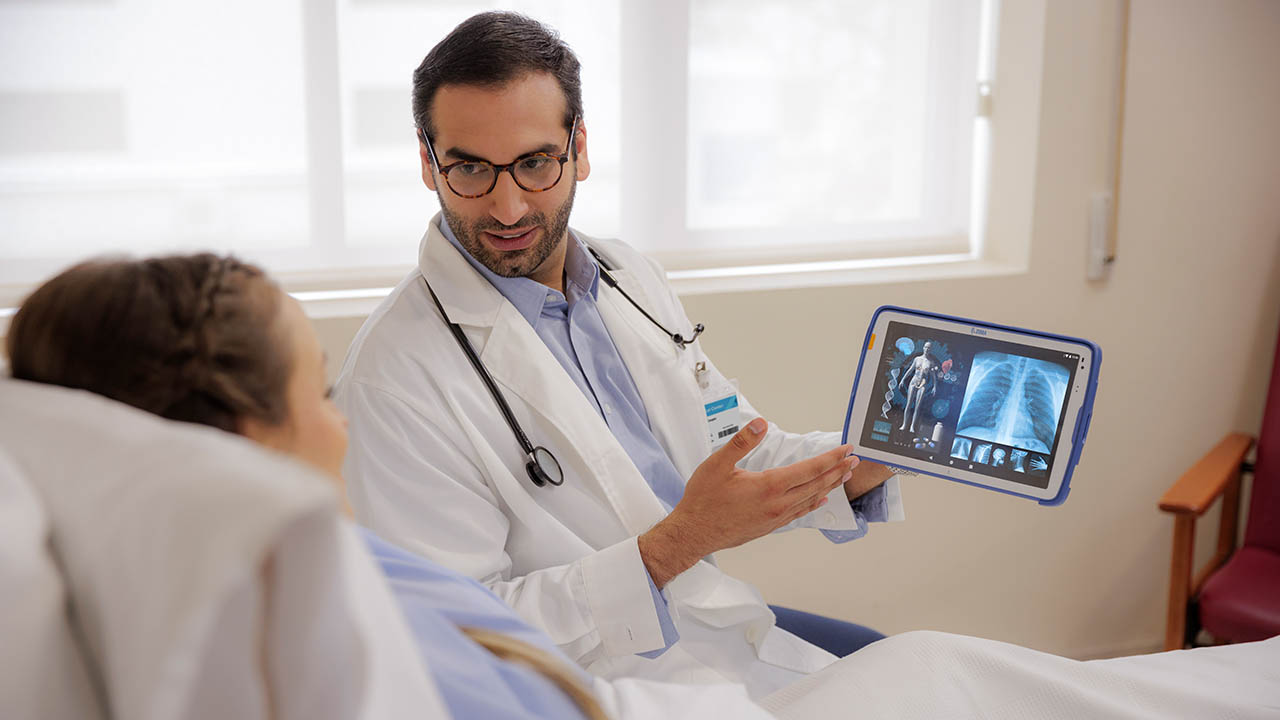
Why Let Inadequate Tech Interfere with Patient Care?
A healthcare professional’s goal is to deliver quality care to their patients. Yet, every day new and different challenges arise, alongside a long list of task-driven administrative work plus an unpredictable flow of emergencies to attend to. In such a fast-paced, rapidly changing environment, caregivers need purpose-built equipment and technology they can rely on every minute of every shift, otherwise everything slows down and the quality of patient care is at risk. Time spent finding workarounds equates to less time caring for patients, something I experienced first-hand during a recent hospital visit.
Just the other day, I visited a relative in the hospital and watched incredulously for the better part of a half an hour as a worker unsuccessfully attempted to break into a fob-operated set of drawers filled with the patient’s personal belongings. The clever design had a battery-operated locking device, yet when the battery ran out, there was no way to change it without opening the drawer. Hence the screwdriver-driven raid I witnessed. A tiny example of equipment not built for the job at hand, with a staff member doing their very best to find a workaround.
When time is spent working around faulty equipment, be it a locked drawer, a smashed tablet screen, slow processors, or disinfectant solution seeping into electronic devices, everything slows down. And the pressure is multiplying as data-driven healthcare continues to evolve at a lightning-fast pace.
Digital technology is enabling collation of data – vital statistics, blood test results, the doctor’s diagnosis – which no longer lie hidden in paper-based folders but can be cross-referenced against hundreds of thousands of outcomes to create tailored treatment programs. The power of digitally driven treatment plans is huge. Patients are getting the right treatment at the right time but with ever increasing sophistication.
Yet, without adequate technology, the whole system starts to falter, and caregivers find themselves troubleshooting equipment failures instead of delivering treatment and spending time with patients.
So, what is it that makes medical devices purpose-built? Quite simply, it must be appropriate for the job. Easy in theory yet a minefield in practice.
Let's take tablets as an example. Why is a purpose-built healthcare device such as the Zebra ET40-HC enterprise tablet (Wi-Fi) or the Zebra ET45-HC enterprise tablet (Wi-Fi and cellular) better choices than a mass-produced consumer-grade tablet?
A typical consumer device has computing capability, and it’s mobile. Perfect for idling over social media or browsing the web. Yet, in a hospital environment, there are so many tasks to complete under immense pressure. The computing prowess may be like for like, but, add in medical workflows and the negatives of consumer tablets start to add up.
Say your patient requires medication. Their ID wristband and prescribed drugs must be scanned and linked to their medical record. If you’re using the Zebra ET4x-HC tablet, you won’t have any problems as an enterprise-class barcode scanner is integrated into the device so both scanning and data transfer is effortless. I can’t say the same if you’re using a consumer tablet – or even a consumer smartphone – as these types of devices attempt to achieve the same result with a camera and third-party scanning application, inevitably leading to several defective scans and an irritatingly long delay in collating the information.
CHECK OUT THIS INFOGRAPHIC
Now, let’s assume your patient becomes confused and tries to climb out of bed after receiving the medication. If you have an ET4x-HC tablet in hand, you can use the emergency alert programmable button to call in the wider team for help whilst you deal with the patient. They can aid with immediate tasks, such as provisioning specific medical equipment or preparing for a procedure in a timely way, or just give you an extra pair of hands. No matter how they join in to help, you will be able to focus on calming down the patient and attending to their needs without having to multitask.
Of course, once you’re done with the patient, the tablet needs to be cleaned. Sanitation and cleanliness are of the utmost importance these days, especially in a medical environment. Consumer tablets may be designed for a light wipe now and again, perhaps when the screen is smeared with chocolate after pacifying a child on a family road trip. Yet, the Zebra ET4x-HC rugged tablets are designed specifically for use in the medical field. They can be exposed to the harsh realities of healthcare environments, like blood and bacteria amongst other things, without you having to worry about it serving as a “spreader” for infectious diseases. Zebra’s healthcare-grade tablets can be sanitized to medical standards every time they change hands, before and after every patient interaction, multiple times per hour. That’s right, these enterprise tablets could be thoroughly disinfected hundreds of times a week with tough chemicals and not blip once. They’re made from advanced medical-grade plastics resistant to chemical abrasives, and in a colour that withstands UV light cleaning.
What else distinguishes a medical-grade tablet from a consumer tablet?
The ease of replacing the battery when it inevitably reaches end of life. The ET4x-HC tablet’s battery can be changed out in a few seconds’ time in the field by your front-line workers. A consumer tablet, on the other hand, must be taken out of service and sent into a depot for battery replacement. That means you’ll either need extra tablets to give to workers during that period or you’ll be down some devices.
Another big difference is that, with a consumer tablet, you won’t necessarily have a heads up that the battery is approaching end of life. Workers will just find themselves with a dead device one day. But with the ET4x-HC, you’ll have the advantage of knowing when a battery needs to be replaced – before it powers down for good. That’s because the ET4x-HC comes with the PowerPrecision battery, which is exclusively available with Zebra devices. It constantly monitors and reports on the health of each device battery through a dashboard that anyone with proper credentials can access. So, your team can have fresh batteries on hand for a proactive swap as the current battery’s levels permanently drop.
The Clock is Ticking
These mini patient and clinician journeys go on and on, day in and day out, year after year in healthcare facilities all over the world. So, why give hospital staff a device that could slow them down or make simple tasks tedious?
I know many people think that consumer devices are “good enough” and can get the job done. But good enough isn’t good enough. And I know it’s possible that after two years, a consumer tablet may have survived against all odds and still be in service. However, at the two-year mark, it is outdated by consumer device standards. That means it will stop receiving critical feature updates and security updates, which will introduce new risks for your organization. Consumer original equipment manufacturers (OEMs) bank upon quick churn of devices and don’t prioritize enterprise users’ needs around standardization, stability and support. Their primary market is consumers. Plus, the consumer tablet will have suffered more wear and tear than it was built to endure during those two years (since it wasn’t built for a healthcare environment). Therefore, that consumer tablet – and your entire fleet – will be neglected and you will be forced to refresh in just 24 months.
On the flip side, the purpose-built Zebra ET4x-HC tablet will still be going strong. In fact, it will last up to six years with ease – with the correct Zebra OneCare™ service package. In many cases, this is triple the lifecycle compared to that of a consumer tablet – before you tack on the other advantages of a purpose-built healthcare tablet. For example, the Zebra ET4x-HC tablet is tested to the latest military durability standards and confirmed to be useable in extreme heat or sub-zero temperatures. It is also rain proof and drop proof to 3.3 ft/1 m. Additionally, it has an ecosystem of healthcare enterprise-grade accessories, including a disinfectant-ready hand strap for easy portability, multi-slot charging cradles, and a presentation stand to create a kiosk-like patient self-check-in solution in the waiting room. There’s also a VESA mount adapter so you can easily mount the tablet bedside to give patients more control of their care. They can use the tablet to contact their nurse, view their own medical records, play games, order food, and more. Watch this:
The ET4x-HC tablet is also pre-loaded with enterprise software to maximize caregivers’ productivity and minimize IT complexities of device management.
“So, what's the catch?” you’re probably asking. “Buying purpose-built healthcare tablets seems the obvious choice for healthcare providers. But normally there is a price hike associated with such added value.”
Well, there’s no catch! The ET4x-HC has got you covered from a performance and cost perspective. It doesn't compromise on features, yet it remains highly competitive against consumer devices from a pricing perspective. In fact, the total cost of ownership (TCO) is lower with the ET4x-HC while the total benefit of ownership (TBO) is far higher.
The proof is in the pudding. Just ask Misty Allen, Digital Business Partner, East Sussex Healthcare NHS Trust (ESHT), UK.
“Our existing iPads were coming to the end of their service life, so we needed to upgrade to newer, purpose-built, and easier to manage devices suitable for a range of hospital environments. Collaborating with Zebra Technologies, we have started trialling ET4x-HC enterprise healthcare tablets for our clinical systems on a medical ward at the Conquest Hospital, East Sussex Healthcare NHS Trust. The aim is to use these tablets to help improve our healthcare staff efficiency, care quality and patient experience.”
So, our advice is clear. Buy once. Buy smart. Make sure the devices you buy for use in healthcare environments are purpose-built for their job to eradicate unnecessary workarounds and free up time for caregiving – quality caregiving that improves patient experiences and outcomes, that is.
###
Editor’s Note:
For more information about the ET4x-HC and other technology solutions purpose built for healthcare workers visit www.zebra.com/et4x-hc
###
You may also be interested in these posts:

Lorna Hopkin
Lorna Hopkin is Product Marketing Advisor at Zebra Technologies with responsibility for Zebra healthcare solutions and advanced location technologies. Lorna joined Zebra in August 2018 as part of its acquisition of rugged tablet specialist Xplore Technologies.
Lorna is a chartered marketer and has two and half decades’ experience across a wide range of industries. At Zebra, she has launched a variety of products into the healthcare space and other verticals.
Lorna is a tireless advocate for health and fitness at Zebra and in her spare time participates in Ironman competitions and enjoys writing about her experiences at https://theordinaryironman.com/






